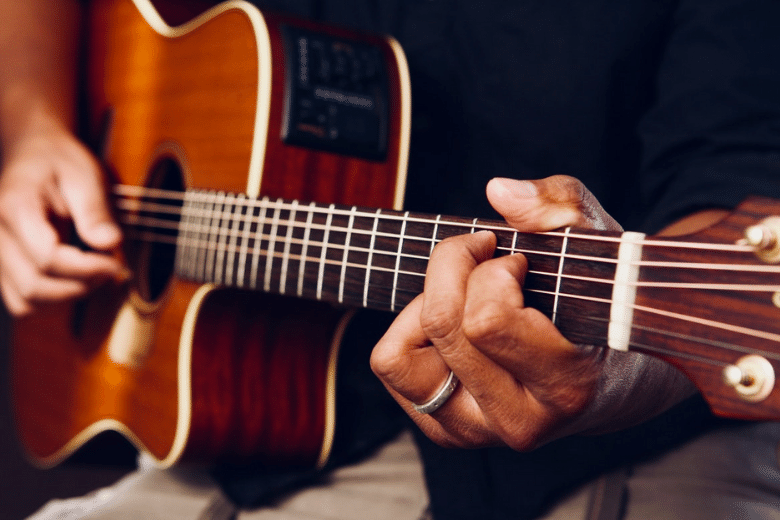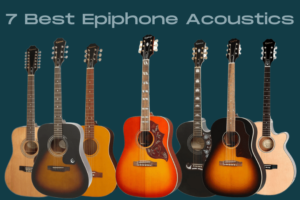Fingerstyle guitar playing can be used in all music genres today. We have found the best deals around for the 5 best fingerstyle guitars.
Fingerstyle occurs when guitar players use their fingers or fingernails to pluck the strings of the instrument instead of a pick.
Once used mainly for performing folk-style music and ballads, fingerstyle playing is now common in all types of music.
In my experience, the best guitar for fingerstyle performance must be extremely responsive with a lighter touch, than guitars played with a pick.
After much comparison, our overall winner is the Fender CD-60 Dreadnought Acoustic Guitar.
Quick Glance: 5 Best Fingerstyle Guitar
- Fender CD-60s Dreadnought Acoustic Guitar
- Yamaha APXT2 3/4-Size Acoustic-Electric Guitar
- The Loar LO-18-VS Adirondack Top L-00 Acoustic Guitar
- Fender Malibu Player – California Series Acoustic Guitar
- Guild M-240e Acoustic Guitar in Natural
What Is Fingerstyle Guitar?
Fingerstyle is a form of guitar playing in which each note is played using the fingers instead of a pick. Guitarists playing blues, jazz, classical guitar, and rock music all incorporate this style today.
Fingerstyle enables a guitarist to perform multiple parts of a song or composition at once.
Using this style, the guitarist can play the melody, bass line, and accompaniment simultaneously.
This method of playing makes it possible for a single guitarist to perform an entire piece of music. Without the need for other musicians, one player can play every note of the song or piece, producing full sound.
The Advantages of Choosing Acoustic Guitars For Fingerstyle
The best guitars for fingerstyle playing are designed to help you play beautiful music and produce full sound using your fingers.
These instruments generally feature wider string spacing than other acoustic guitars. On average, this spacing equals 57 mm, and it may be as much as 59 mm.
With this extra spacing, your fingers have more room to play without touching the other strings.
This additional space is especially helpful when you play arpeggios. Many fingerstyle guitars have a nut width of 43 mm., while the average acoustic guitar has 45 mm.
With wider string spacing, guitarists can play music passages with fast alternate thumb and fingerpicking. They can produce base notes, melody lines, and accompaniment without any contact with other strings.
Many guitar players prefer this wider spacing once they get accustomed to it.
There is a drawback to wide string spacing for some guitarists. The fretting hand must stretch more.
At times, stretching can be rather difficult for playing notes in songs or instrumental music. For players with long fingers, this is easier to overcome than for those with shorter finger lengths.
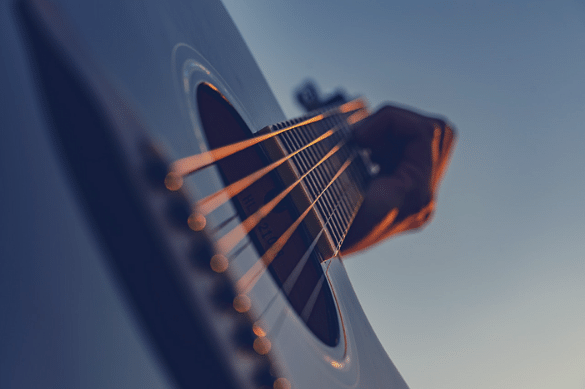
Best Acoustic Guitars for Fingerstyle: Full Review
1. Fender CD-60s Dreadnought Acoustic Guitar

This Fender Mahogany acoustic guitar has a dreadnought body style. It’s design combines a solid mahogany top with scalloped X bracing and mahogany back and sides. A neck scale length of 25.5″, offers a fingerboard with rolled edges for comfortable easy playing.
For producing the tops of acoustic guitars, solid spruce is the top-rated standard tonewood in use today.
Few other wood types can compete with its strength, dynamic range, and tonal brightness. It is excellent for virtually any playing style for acoustic guitar, including heavy strumming, fast-paced flatpicking, and sensitive fingerpicking.
This instrument’s mahogany back and sides create a balanced tone with an abundance of volume and midrange. Its also worth knowing the body wood is made from laminated mahogany, this gives you an all round louder projection.
The fender CD60s also comes in sunburst, natural, and black. They really are beautiful looking guitars.
The best guitar for fingerpicking in all of my review.
Pros
- This guitar is ideal for fingerstyle by novices and experts alike.
- Easy to play! Without any adjustment, this guitar plays well right out of the box.
- This guitar has a beautiful look and sound quality.
- Fender is a massive leader in acoustic and electric instruments
- Scalloped X bracing
Cons
- Fret edges on this model may need some mild filing.
>>Check Price On Sam Ash Music<<
2. Yamaha APXT2 3/4-Size Acoustic-Electric Guitar: With ART-Based Pickup System

The Yamaha APXT2 acoustic electric is a 3/4-size model of the popular acoustic-electric APX500III. It is compact and well-constructed, making it ideal for taking on the road.
This guitar features an Acoustic Resonance Technology (ART)-based pickup system plus the Yamaha proprietary tuner. These features provide excellent accuracy and sensitivity.
This model also includes mid-boost EQ for use with the chromatic precision tuner, for maximum sound shaping and control.

Featuring a spruce top, this guitar also has a back and sides made of meranti. It offers System68 electronics as well as tone and volume controls. Also comes with a gig-bag.
Pros
- This guitar is a great choice for regular playing or tuned up a 4th, to A (as a soprano guitar).
- The built-in tuner is an excellent feature of this model.
- This instrument travels well, fitting easily into airplane overhead bins and car trunks.
- Comfortable easy to play neck
- Yahama are the leaders in lower-priced acoustic guitars
Cons
- When strumming, this small guitar may sound a bit thin and tinny.
>>Check Price On Sam Ash Music <<
3. The Loar LO-18-VS Adirondack Top L-00 Acoustic Guitar: Displays Vintage Sunburst

This acoustic guitar model has a top composed of solid Adirondack spruce with a body and back of mahogany.
It offers a 1-3/4-inch nut width and a V neck profile. It is known for its combined responsive bass and fast blues-style decay.
This guitar also has unique volume and resonance due to its solid Adirondack spruce top.
Comfort for multiple playing styles is supported by the thin V vintage neck profile. The top-binding of this guitar and the retro sunburst reflect the style and charm of its earlier era. The bone nut and saddle provide additional style.
Pros
• Kluson black tuning buttons contribute to the stylish look of this guitar.
• D’Addario strings lend fashion and flair to this guitar design.
• This guitar is a vintage design enthusiast’s dream at a great price.
Cons
• Some players would prefer this guitar in a lighter color.
4. Fender Malibu Player – Acoustic Electric Guitar
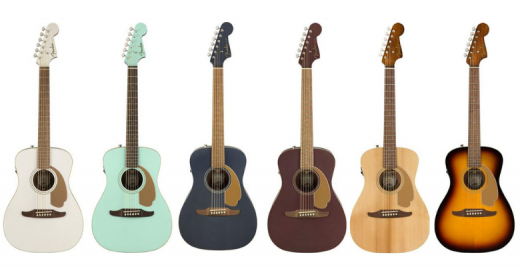
This guitar design features a small body and comfortable feel, this encourages beginner and intermediate players to master new chords and tunes.
The Fender Malibu displays a painted body with a solid spruce top and a mahogany neck, back, and sides. The neck features a slim-taper “C” profile shape, a 24.1″ scale length and the fingerboard and bridge are walnut.
With its tone balance and articulate sound, this guitar is equally popular in stage performance and in the studio.
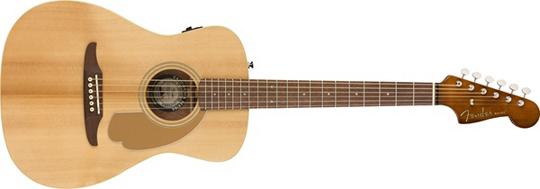
It supports all playing styles and offers optimized bracing for superb resonance.
This model has a GraphTech NuBone nut and saddle, a Fishman preamp system to ensure natural sound through an amplifier. It also offers superior playability and an innovative style.
Pros
• This guitar has a beautiful sound and style.
• This instrument offers excellent playability at a great price
• As a lightweight guitar, this model offers full acoustic sound projection.
Cons
• You may need to adjust the truss rod to your liking.
Body Size/Shape Malibu, Body Wood Mahogany, Top Solid Sitka Spruce
Bracing Scalloped “X”, Cutaway None, Top/Body Finish Gloss Poly, Neck Wood Mahogany, Neck Shape Slim “C”, Neck Finish Satin, Scale Length 24.1″, Fingerboard Walnut, Fingerboard Radius 15.75″, Number Of Frets 20, Nut Width 1.69″, Bridge Type Walnut Modern Viking, Nut & Saddle Graph Tech® NuBone Nut, Tuning Machines Sealed Gears, Electronics Fishman, Series California Series, Model Malibu Player Acoustic Electric Guitar
5. Guild M-240e Acoustic Guitar in Natural: Concert Size
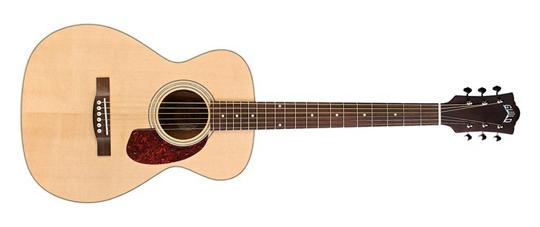
This concert-size acoustic/electric guitar has a Sitka spruce-wood top.
Its body, back, and neck are made of African mahogany. It has a vintage-shaped neck with a nut width of 1-3/4 inches, and the scale length is 24-3/4 inches.
This guitar model offers superior balance with a delicate tone and is easy to play. It ships with a lightweight Guild case.
This guitar design features a fingerboard and bridge made of Indian rosewood as well as bone nut and saddle. It also displays a mother-of-pearl rosette and a tortoiseshell pickguard.
In addition, this model exhibits the Guild Chesterfield headstock emblem that appeared on models in the 1960s. It is currently available in the Natural gloss finish.
Comes fitted with a Guild/Fishman Sonitone GT-1 Preamp System
Pros
• This guitar has a beautiful tone balance and is easy to play.
• The combination of woods and design elements displayed by this guitar make it extra attractive.
• This guitar’s vintage-shaped Guild neck and Chesterfield headstock emblem give it special appeal.
Cons
• Some guitar buyers may not want a concert-size instrument or vintage design elements.
>>Check Price On Sam Ash Music<<
Category Acoustic-Electric Guitar, Body Style Concert, Cutaway No, Scale Length 24.75″
Number of Frets 20, Top Wood Solid African Mahogany, Body Wood Mahogany, Neck, Wood Mahogany, Fingerboard Wood Pau Ferro, Color Natural, SeriesWesterly Collection
Model M-240E
Outstanding Features of Top-Rated Fingerstyle Guitars
Primary outstanding design features and qualities of a great fingerstyle guitar, aside from wider string width, include the following:
• Smaller Body Size.
Guitars designed for fingerstyle have smaller bodies than other acoustics. This feature creates even sound quality and easy instrument playability.
Traditionally, the majority of acoustic instrument designs support a big sound and a heavy bass output.
For fingerstyle guitar playing, even expression of all strings and notes is the desired result.
In addition, for many players, large guitar bodies may be difficult to reach around. They may be fine for open-position strumming. Yet for more involved string playing requiring agile, fluid movement, a smaller guitar body is definitely a plus.
• Cutaway Feature.
In guitar designs, the cutaway enables easier access to the strings located above the 12th fret.
This part of the instrument neck is used regularly by electric guitar players. Yet this element is often ignored in acoustic guitar design.
Many acoustic guitar models do not include the cutaway, since this is not the area where the acoustic has the best sound.
However, in fingerstyle, you want the option of accessing this area. The cutaway design is helpful to a fingerstyle guitarist for harmonics, the versatility of arrangements, and solos.
If you’re unsure of whether to follow the acoustic or electric guitar path of fingerpicking. We can help you decide with: ‘Acoustic Vs Electric Guitar: A Complete Beginners Guide’
• Easy Action.
In guitar playing, “action” describes the string height and tension over the fretboard.
The action has a significant effect on how much pressure you put on the strings against the fretboard. It also affects the ease with which you can change hand positions. Easy, comfortable fingering of your guitar fretboard is essential.
• Wood Type.
Do not underestimate the importance of wood type.
There is a science behind the different types of wood, and which is best in certain parts of a guitar. Far too much to fit into one paragraph, so we’ve got you covered here: ‘The Ultimate Acoustic Guitar Wood Guide: How Does Wood Affect Your Tone?’
How to Select Your Ideal Guitar for Fingerstyle
To select the ideal guitar that is best-suited for great fingerstyle playing, you may want to focus on the following advice and tips:
• Playability.
Audition any guitar that you are considering buying. Try it out, covering the entire neck with the notes, songs, or compositions that you know. Particularly for the first frets, try bar chords to see if you get a pure, clean sound.
• Tone Quality.
When playing the guitar, does it produce a clear sound projection with color and volume? Be wary of any guitar on which the strings buzz. Listen carefully when playing open strings or fretted notes.
• Tuning Quality.
Make sure that any guitar that you may be considering buying stays in tune. Ensure the fretted notes are at the correct pitch when the open strings are properly tuned. Be aware, also, that if a guitar has a badly set neck or mispositioned frets, you cannot hope to play anything in tune on this instrument.
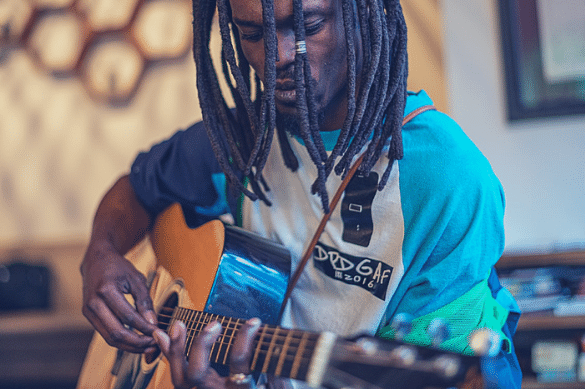
Guitar Body Shape.
The three most frequently purchased guitar body types:
• Dreadnought Body.
These guitar bodies produce deep bass tones and crystalline high notes. Yet the voice has a fairly even balance across the whole spectrum in terms of tone. A Dreadnought guitar is most appropriate for players looking for a pleasing blend of powerful sound and crisp articulation. Be aware that some low-cost models may produce a brassy or loud, overstated sound.
• Grand Concert.
With a smaller body size, this guitar is ideal for fingerstyle. It is especially comfortable to play while seated. It offers a pleasing sound with a greater mid-range and less boomy and overpowering sound.
• Grand Auditorium.
The proportions of this guitar are between those of a Grand Concert and a Dreadnought guitar. Particularly in the mid-range, this instrument offers quality balance across the entire spectrum of tonality. It offers notes with good definition and excellent clarity. This guitar is well-suited for fingerstyle as well as strumming.
Many experienced players recommend choosing a guitar designed with a cutaway, especially if you’re a beginner. This enables you to access the entire fretboard easily, including the higher frets.
The Dreadnought and Concert are the most popular shapes of acoustic guitar. Here are the different characteristics between the two:
The Dreadnought Guitar
Guitar Body Shapes
The Dreadnought is the more common style of guitar on the market. It’s larger in size and exhibits a boxy shape.
This is a major factor when considering the tonal values of both types of guitars.
Tone
The Dreadnought shape gives the player a nice delicate midrange scoop. You get more depth and low end. The top-end mid-tones are notably much snappier than a Concert.
There is a great deal of difference in clarity between the guitars. The Dreadnought has a far more transparent sound due to the straighter body shape. This results in a wider proportional EQ.
A Dreadnought Guitar is suited to:
The benefits of the midrange scoop on a dreadnought are ideal for singer-songwriters or acoustic guitarists in bands. This is exactly where the vocal frequencies sit in the mix.
As a Dreadnought can project its volume more efficiently in comparison to the Concert models. This attribute makes it perfect for the chord strummer and live musician.
The Concert Guitar
Guitar Body Shape
The main difference you’ll notice is the size. A Concert guitar is smaller than a Dreadnought. It has a more rounded shape and a much deeper waste taper.
The dreadnought on the other hand has a wider waist and displays a straighter longer body style.
Tone
The Concert sized guitar is suited to more complex chords and voicings. As it’s smaller in size, it has a more controlled bottom end.
The Concert gives you a better mixture of mids and treble tone. It’s coherent and more expressive with chords, especially higher up the fretboard.
A Concert Guitar is suited to:
As a Concert guitar is lighter and shorter, it instantly appeals to smaller players. In a sitting position, it is considerably more comfortable than a dreadnought. Especially for children and beginners.
Concert guitars are suited towards a finger playing style or the articulate chord guitarist. A perfect choice for the musician looking to play alone.
FAQ About Choosing a Guitar for Fingerstyle
The following are frequently asked questions about fingerstyle from beginners and intermediate guitarists:
Is it difficult to play fingerstyle guitar?
If you are a complete beginner, fingerstyle can be somewhat difficult. Yet with regular practice, the fingerstyle will gradually become easier, and you will most likely enjoy its challenges. Let’s be honest, no part of playing the guitar is ‘easy’, if it was, everybody would be playing. That’s what makes a guitarist special.
Are long fingernails needed for playing fingerstyle guitar?
Having long fingernails does not necessarily help you play better fingerstyle guitar. Yet some musicians keep their fingernails long, mainly because this can make strumming more effective. However, many of the ‘best’ fingerstyle guitarists play with their fingers only.
What are the best strings to use when playing fingerstyle guitar?
Individual players have their own preferences, but most experts recommend these gauge strings for playing fingerstyle guitar: For acoustic guitar, the strings should usually be 0.12. (For electric guitars, 0.10 strings are a good choice.)
AuthorityGuitar has an in-depth guide for ‘What Are Best Acoustic Guitar Strings For Beginners?’
Informed Advice and Comparisons.
Seek advice from experienced guitarists and from guitar sellers. However, never feel pressured by others to choose a certain guitar. Let the final purchasing decision be entirely your own.
Now, it is time for you to select from our best fingerstyle guitars. We hope this guide has been of help to you in making your choice, yet the final buying decision is yours.
You can now decide which brand and model of fingerstyle guitar is the ideal one to completely satisfy and even surpass your desires, preferences, and needs.
Happy Shopping!

